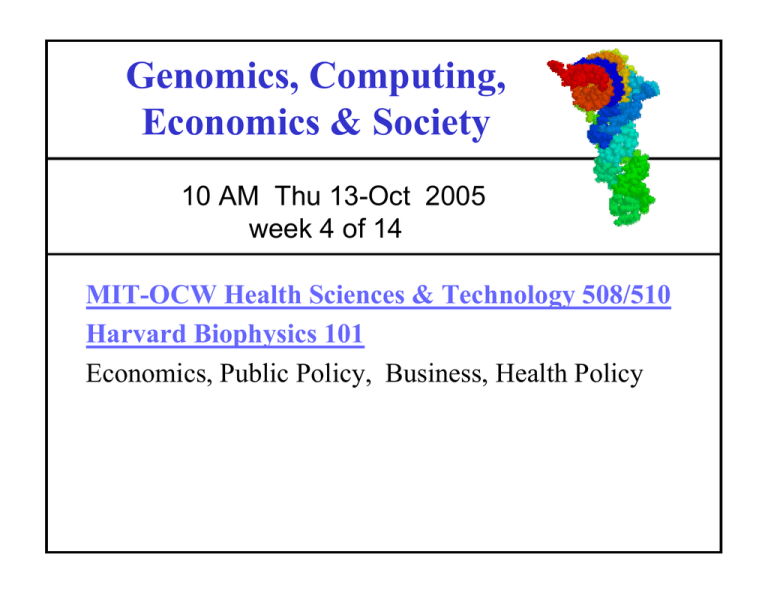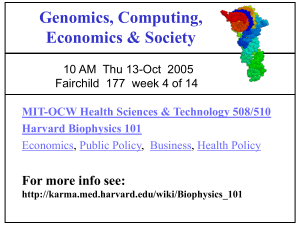Genomics, Computing, Economics & Society 10 AM Thu 13-Oct 2005
advertisement

Genomics, Computing, Economics & Society 10 AM Thu 13-Oct 2005 week 4 of 14 MIT-OCW Health Sciences & Technology 508/510 Harvard Biophysics 101 Economics, Public Policy, Business, Health Policy Class outline Photo removed due to copyright reasons. (1) Topic priorities for homework since last class (2) Quantitative exercises: psycho-statistics, combinatorials, random/compression, exponential/logistic, bits, association & multihypotheses, linear programming optimization (3) Project level presentation & discussion (4) Sub-project reports & discussion: Personalized Medicine & Energy Metabolism (5) Discuss communication/presentation tools (6) Topic priorities for homework for next class Population drop from 12,000 to 2500 in 100 years; forest of palms to zero. Easter Islanders deforested the island in the process of erecting 800 moai statues (rolled over logs from the quarry to their raising sites), construction of fishing boats and buildings, fires. Photo removed due to copyright reasons. Easter Island Reasons: 1. Lack of FBA & ODE models 2. Competition among tribes 3. Tragedy of commons 4. Lack equilibrium 5. Future tree vs current tree 6. price vs (under) value 7. Ecologically naïve: erosion 8. 7 generations Native Amer. 9. War, religion, suicide 10. Vandalism, lack of police Energy & CO2 Sequestration Humans consume 2kW per person = 1010 kW. 0.2 - 10 kW Sunlight hits the earth at 40,000 times that rate (70% ocean). CO2/yr: Fossil fuel use releases 5 Gton. Ocean & terrestrial productivity = ~100 Gton each. Autotrophs: 1026 Prochlorococcus cells globally (108 per liter) Lab:100X Sequestration v. respiration v. use: heterotrophs (Pelagibacter), phages, predators (Maxillopoda, Malacostraca, herring) 0.1 µ 0.1 mm 6 cm Photos removed due to copyright reasons. http://www.gsfc.nasa.gov/gsfc/service/gallery/fact_sheets/earthsci/terra/earths_energy_balance.htm http://clear.eawag.ch/models/optionenE.html http://en.wikipedia.org/wiki/Copepod Morris et al. Nature 2002 Dec 19-26;420(6917):806-10. Photo removed due to copyright reasons. Think globally; act locally Lithosphere (0.2% C, 75% SiO2) 110 C at 4 km Diameter = 1.3e6 m = 5e22 g human=6e9 * 1e5 Biosphere 3e15 g (dry wt. marine); 2e18 g (land) Microbial hydrosphere 1.4e21 g? = 1e27 cells? 1e31 =4e33 bp Anthrosphere (23% C) = 6e23 cells = 4e32 bp. "biomass of more than 2e18 g contains a total biopolymer sequence on the order of 1e38 residues." Figure removed due to copyright reasons. fig Giant Larvacean Houses: Rapid Carbon Transport to the Deep Sea Floor Photo removed due to copyright reasons. An unresolved issue in ocean science is the discrepancy between the food requirements of the animals living on the deep sea floor and their food supply, as measured by sediment traps. A 10-year time-series study of the water column off Monterey Bay, revealed that the discarded mucus feeding structures of giant larvaceans carry a substantial portion of the upper ocean's productivity to the deep seabed. .. not detected by conventional sampling methods and thus have not been included in calculations of vertical nutrient flux or in oceanic 8 mg of C /m^2/day (*4e14 m^2 = 3e12g = 3million tons) .. Carbon that reaches the deep sea floor is effectively removed from the atmosphere for geological time scales. Robison, et al. Science. 2005 308:1609-11. http://www.fisherycrisis.com/strangelove.html Biodiesel: What species? Photo removed due to copyright reasons. New pathway for long-chain n-alkane synthesis via 1-alcohol in Vibrio furnissii M1. Park MO. J Bacteriol. 2005 Feb;187(4):1426-9. "Photosynthesis by marine diatoms generates as much as 40% of the 45 to 50 billion metric tons of organic carbon produced each year in the sea (1), and their role in global carbon cycling is predicted to be comparable to that of all terrestrial rain forests combined (2, 3)." EV Armbrust, et al. Science. 2004 306:79 The Genome of the Diatom Thalassiosira Pseudonana. 1. DM Nelson, et al. Global Biogeochem. Cycles 9, 359 (1995) 2. CB Field, et al., Science 281, 237 (1998) Photo removed 3. DG Mann, Phycologia 38, 437 (1999) due to copyright reasons. Biodiesel: What species? Photo removed due to copyright reasons. "Prochlorococcus and Synechococcus remove about 10 billion tons of carbon from the air each year -- as much as two-thirds of the total carbon fixation that occurs in the oceans." http://doegenomestolife.org/news/081303news.shtml "3.9E13 [tons of carbon] are inorganic and 1E12 organic.. annual gross primary production covers 1.2E11 tons, the net primary production is 0.57E11 tons of carbon.. 0.43E11 tons of carbon is made up by marine plants," http://www.biologie.uni-hamburg.de/b-online/e54/54d.htm "terrestrial plants take up more than 100 PG (billion metric tons) of carbon annually, and plants and microorganisms return approximately as much to the atmosphere in respiration. This exchange is 20 times greater than the amount of carbon released by fossil fuel combustion." http://www.nap.edu/books/0309040892/html/78.html Biodiesel: What species? Photo removed due to copyright reasons. "Approximately two thirds of the net global photosynthetic productivity worldwide is of terrestrial origin.. The efficiency of uncultivated plant life is only about 0.2%. In sugar cane, which is one of the most efficient plants, about 8%.. theoretical maximum efficiency of .. 11%. Solar radiation striking the earth .. 178,000 terawatts, i.e. 15,000 times that of current global energy consumption" Photos removed due to copyright reasons. Biodiesel: What species? www.eere.energy.gov/hydrogenandfuelcells/pdfs/review04/hpd_9_melis.pdf Wild type antenna size = 235 Chl molecules (100%) (PSII=230; PSI=240) Photon use efficiency of WT photosynthesis = ~10% Utilization Efficiency of Absorbed Light Energy by WT: ~5% • tla1 antenna size = 138 Chl molecules (59% of control) (PSII=115; PSI=160) Photon use efficiency of tla1 photosynthesis = ~20% Utilization Efficiency of Absorbed Light Energy by tla1: ~10% 2004 Year Accomplishment • tlaX antenna size = 98 Chl molecules (42% of control) (PSII=80; PSI=115) Photon use efficiency of tlaX photosynthesis = ~30% Utilization Efficiency of Absorbed Light Energy by tlaX: ~15% • Long-term goal: 66 Chl molecules (28% of control) (PSII=37; PSI=95) Photon use efficiency of photosynthesis goal = ~60% Utilization Efficiency of Absorbed Light Energy goal: ~30% Photo removed due to copyright reasons. Biodiesel: What species? Photo removed due to copyright reasons. "Green algae growing under full sunlight .. have disappointingly low solar conversion efficiencies [due to] a tendency to assemble large arrays of ..antennae .. In addition to wasteful dissipation of excitation and .. photoinhibition of photosynthesis .. cells deeper in the culture are deprived of much needed sunlight" Polle JE, Kanakagiri SD, Melis A. Planta. 2003 May;217(1):49-59. tla1, a DNA insertional transformant of the green alga Chlamydomonas reinhardtii with a truncated lightharvesting chlorophyll antenna size. Why? 1. Lab artefact of density 2. Group selection 3. Selfish (game theory) 4. Effects on travel 5. Tradeoff two functions Biodiesel: What species? Photo removed due to copyright reasons. In the US, roughly 450 million acres of land is used for growing crops, with the majority of that actually being used for producing animal feed for the meat industry. Another 580 million acres is used for grassland pasture and range, according to the USDA's Economic Research Service http://www.unh.edu/p2/biodiesel/article_alge.html to replace all transportation fuels in the US, we would need 140.8 billion gallons of biodiesel. To produce that amount would require a land mass of 10 million acres (1/8th the size of the Sonora desert in SW US). Dynamic mass balances on each metabolite Vsyn Vtrans Vdeg Vuse dX i = (Vsyn − Vdeg − Vuse ) − Vtrans = ( S ij v j ) − bi dt Time derivatives of metabolite concentrations are linear combination of the reaction rates. The reaction rates are nonlinear functions of the metabolite concentrations (typically from in vitro kinetics). Where vj is the jth reaction rate, b is the transport rate vector, Sij is the “Stoichiometric matrix” = moles of metabolite i produced in reaction j Flux-Balance Analysis • Make simplifications based on the properties of the system. – Time constants for metabolic reactions are very fast (sec - min) compared to cell growth and culture fermentations (hrs) – There is not a net accumulation of metabolites in the cell over time. • One may thus consider the steady-state approximation. dX = S⋅v −b = 0 dt Flux-Balance Analysis S⋅v = b • Removes the metabolite concentrations as a variable in the equation. • Time is also not present in the equation. • We are left with a simple matrix equation that contains: – Stoichiometry: known – Uptake rates, secretion rates, and requirements: known – Metabolic fluxes: Can be solved for! In the ODE cases before we already had fluxes (rate equations, but lacked C(t). Additional Constraints – – – – – – Fluxes >= 0 (reversible = forward - reverse) The flux level through certain reactions is known Specific measurement – typically for uptake rxns maximal values uptake limitations due to diffusion constraints maximal internal flux α i ≤ vi ≤ β i Flux Balance Example RA x1 B A x2 2C Flux Balances: A: RA – x1 – x2 = 0 B: x1 – RB = 0 C: 2 x2 – RC = 0 RB RC Supply/load constraints: RA = 3 RB = 1 Equations: A: x1+x2 = 3 B: x1 = 1 C: 2 x2 – RC = 0 x1 x2 RC A ⎡1 1 ⎤ ⎡ x1 ⎤ ⎡3⎤ ⎥ ⎢ x ⎥ = ⎢1⎥ B ⎢⎢1 ⎥⎢ 2 ⎥ ⎢ ⎥ C ⎢⎣ 2 − 1⎥⎦ ⎢⎣ RC ⎥⎦ ⎢⎣0⎥⎦ S⋅v = b FBA Example v = S −1b ⎡ x1 ⎤ ⎡0 1 0⎤ ⎡3⎤ ⎢ x ⎥ = ⎢1 − 1 0⎥ ⋅ ⎢1⎥ ⎥ ⎢ ⎥ ⎢ 2⎥ ⎢ ⎢⎣ RC ⎥⎦ ⎢⎣2 − 2 1⎥⎦ ⎢⎣0⎥⎦ ⎡ x1 ⎤ ⎡1 ⎤ ⎢ x ⎥ = ⎢ 2⎥ ⎢ 2⎥ ⎢ ⎥ ⎢⎣ RC ⎥⎦ ⎢⎣4⎥⎦ S⋅v = b −1 v=S b 3 1 B A 2 2C 1 4 FBA • Often, enough measurements of the metabolic fluxes cannot be made so that the remaining metabolic fluxes can be calculated. • Now we have an underdetermined system – more fluxes to determine than mass balance constraints on the system – what can we do? Incomplete Set of Metabolic Constraints • Identify a specific point within the feasible set under any given condition • Linear programming - Determine the optimal utilization of the metabolic network, subject to the physicochemical constraints, to maximize the growth of the cell FluxC Assumption: The cell has found the optimal solution by adjusting the system specific constraints (enzyme kinetics and gene regulation) through evolution and natural selection. Flu xA FluxB Find the optimal solution by linear programming Under-Determined System • • • • • • All real metabolic systems fall into this category, so far. Systems are moved into the other categories by measurement of fluxes and additional assumptions. Infinite feasible flux distributions, however, they fall into a solution space defined by the convex polyhedral cone. The actual flux distribution is determined by the cell's regulatory mechanisms. It absence of kinetic information, we can estimate the metabolic flux distribution by postulating objective functions(Z) that underlie the cell’s behavior. Within this framework, one can address questions related to the capabilities of metabolic networks to perform functions while constrained by stoichiometry, limited thermodynamic information (reversibility), and physicochemical constraints (ie. uptake rates) FBA - Linear Program • For growth, define a growth flux where a linear combination of monomer (M) fluxes reflects the known ratios (d) of the monomers in the final cell polymers. ∑d ⋅ M ⎯⎯⎯→ biomass v growth M allM • A linear programming finds a solution to the equations below, while minimizing an objective function (Z). Typically Z= νgrowth (or production of a key compound). S⋅v =b • i reactions vi ≥ 0 α i ≤ vi ≤ β i vi = X i Class outline (1) Topic priorities for homework since last class (2) Quantitative exercise (3) Project level presentation & discussion (4) Sub-project reports & discussion (5) Discuss communication/presentation tools (6) Topic priorities, homework for next class


